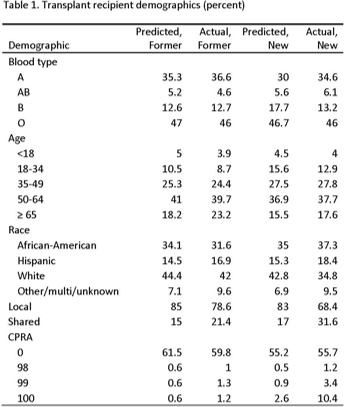Projection versus Reality: KPSAM and KAS.
Scientific Registry of Transplant Recipients, Minneapolis, MN.
Meeting: 2016 American Transplant Congress
Abstract number: C72
Keywords: Allocation, Kidney, Kidney/pancreas transplantation
Session Information
Session Name: Poster Session C: Economics, Public Policy, Allocation, Ethics
Session Type: Poster Session
Date: Monday, June 13, 2016
Session Time: 6:00pm-7:00pm
 Presentation Time: 6:00pm-7:00pm
Presentation Time: 6:00pm-7:00pm
Location: Halls C&D
On December 4, 2014, the national kidney allocation system (KAS) was substantially revised. The decision to revise was based in part on results from the kidney-pancreas simulated allocation modeling (KPSAM) software, which projected changes in the demographics of transplant recipients and median posttransplant survival under the proposed system. Of interest to the transplant community is how well KPSAM predicted the impact of the new KAS.
We compared two simulated and two real cohorts under the former and new systems. Simulated results were based on 2010 cohorts. The actual cohorts are from December 4, 2013-September 4, 2014 (pre-KAS), and December 4, 2014-September 4, 2015 (post-KAS). To match the amount of data available post-KAS, the simulated results were limited to the first 9 months. A sensitivity analysis showed negligible differences between 9- and 12-month simulated outcomes.
Increases of 1% and 0.8% in transplants in black and Hispanic candidates, respectively, were projected; in reality, transplants increased by nearly 6% and 1.5% (Table). Likewise, increases of 0.3% and 2.0% in candidates with cPRA 99% and 100%, respectively, were projected; in reality, increases were 2% and 9%. The increase in sharing was also larger than predicted, nearly 10% vs. the 2% predicted. This is likely related to the success of candidates with cPRA 100% and 99%, to whom organs are mandatorily shared. Several changes were less robust than predicted. Transplants in ABO:B candidates increased by 0.5% vs. the 5% expected, and in candidates aged 18-34 years 4% vs. the 5% expected. Distribution of waitlist deaths by age was well predicted.
KPSAM accurately predicted the direction but not magnitude of most demographic changes. SAM predictions tend to be conservative, likely due to inability to predict behavioral changes in listing and organ acceptance, and reliance on historic data.

CITATION INFORMATION: Gustafson S, Israni A, Pyke J, Salkowski N, Snyder J, Kasiske B. Projection versus Reality: KPSAM and KAS. Am J Transplant. 2016;16 (suppl 3).
To cite this abstract in AMA style:
Gustafson S, Israni A, Pyke J, Salkowski N, Snyder J, Kasiske B. Projection versus Reality: KPSAM and KAS. [abstract]. Am J Transplant. 2016; 16 (suppl 3). https://atcmeetingabstracts.com/abstract/projection-versus-reality-kpsam-and-kas/. Accessed December 17, 2025.« Back to 2016 American Transplant Congress
